In the digital age, the demand for coding education has skyrocketed, with more people than ever seeking to master the art of computer programming. Whether you’re a beginner aiming to break into the field or an experienced developer looking to sharpen your skills, online coding tutorials have become a go-to resource. However, not all tutorials are created equal. To truly benefit from these resources, it’s essential to understand what makes an online coding tutorial effective and how you can make the most of these learning opportunities.

The Rise of Online Coding Tutorials
The popularity of online coding tutorials stems from their accessibility and flexibility. Unlike traditional programming lessons, which require physical attendance, online tutorials allow you to learn at your own pace, anytime and anywhere. This convenience has made them a favorite among both aspiring developers and seasoned professionals.
However, the sheer volume of available tutorials can be overwhelming. With countless resources at your disposal, how do you choose the ones that will truly help you advance in your coding journey? Understanding the key elements of effective tutorials can make all the difference.
Key Elements of Effective Online Coding Tutorials
- Structured Learning Paths: One of the hallmarks of an effective online coding tutorial is a well-structured learning path. Rather than presenting isolated lessons, the best tutorials guide you through a comprehensive curriculum that builds your knowledge step by step. For example, a tutorial on full-stack development might start with basic HTML and CSS before moving on to more complex topics like JavaScript, server-side programming, and database management. This gradual progression ensures that you develop a solid foundation before tackling more advanced concepts.
- Hands-On Coding Exercises: Theory alone is not enough to master coding. Effective tutorials incorporate hands-on coding exercises that allow you to apply what you’ve learned in a practical setting. These exercises not only reinforce your understanding of the material but also help you develop problem-solving skills that are crucial in real-world programming projects. Whether you’re learning front-end development or back-end development, coding exercises are essential for transforming knowledge into expertise.
- Interactive Learning: Interactivity is a key factor in keeping learners engaged and motivated. Effective online coding tutorials often include interactive elements such as quizzes, coding challenges, and real-time feedback. For instance, when working on a data structures or algorithms course, being able to test your solutions immediately and receive feedback can significantly enhance your learning experience. Interactive tutorials also help you retain information better, making your study sessions more productive.
- Real-World Applications: The best online coding tutorials connect theoretical concepts to real-world applications. For instance, instead of simply explaining how a particular algorithm works, an effective tutorial might demonstrate its use in optimizing a popular software feature or solving a common coding challenge. By linking lessons to real-world scenarios, these tutorials make the material more relatable and easier to understand. This approach is particularly valuable for learners who want to see how their coding education can be applied in professional settings.
- Community and Support: Learning to code can be challenging, and having access to a supportive community can make a big difference. Effective online coding tutorials often provide forums or discussion groups where learners can ask questions, share insights, and collaborate on projects. Additionally, many tutorials offer instructor support, allowing you to get help when you’re stuck on a difficult concept or coding exercise. Engaging with a community of like-minded learners can also help you stay motivated and inspired throughout your coding journey.
Common Pitfalls in Online Coding Tutorials
While online coding tutorials offer many advantages, there are also common pitfalls that can hinder your progress if you’re not careful.
- Lack of Depth: Some tutorials provide only a superficial overview of topics, leaving you with gaps in your knowledge. It’s important to choose tutorials that delve deeply into the subject matter and offer comprehensive explanations. For example, if you’re studying software engineering or full-stack development, look for tutorials that cover both the theoretical and practical aspects of these fields.
- Overemphasis on Theory: On the flip side, some tutorials focus too heavily on theory without offering enough practical experience. As mentioned earlier, hands-on coding exercises are crucial for reinforcing what you’ve learned. Without them, you may struggle to apply your knowledge in real-world situations, such as building or contributing to programming projects.
- Inconsistent Quality: The quality of online coding tutorials can vary widely. Some are created by experienced educators and industry professionals, while others may be put together by individuals with limited teaching experience. Always research the credentials of the tutorial creators and read reviews from other learners to ensure you’re choosing a high-quality resource.
How to Maximize Your Learning from Online Coding Tutorials
To get the most out of online coding tutorials, it’s important to approach them with the right mindset and strategies.
- Set Clear Goals: Before starting a tutorial, define what you want to achieve. Whether it’s mastering a specific programming language, completing a complex coding project, or preparing for a coding workshop, having clear goals will help you stay focused and motivated.
- Practice Consistently: Coding is a skill that requires regular practice. Set aside dedicated time each day or week to work through your tutorials and complete coding exercises. Consistent practice is key to retaining what you’ve learned and making steady progress.
- Apply What You Learn: Whenever possible, apply the concepts and techniques you’ve learned in your own programming projects. This could involve contributing to open-source projects, building your own applications, or participating in coding challenges. Applying your knowledge in a practical context will help you solidify your skills and gain confidence in your abilities.
- Seek Feedback: Don’t be afraid to seek feedback on your work, whether from instructors, peers, or online communities. Constructive feedback can help you identify areas for improvement and guide your learning process.

Online coding tutorials have revolutionized the way we learn programming, offering unprecedented access to high-quality education. However, to truly benefit from these resources, it’s important to choose tutorials that are well-structured, interactive, and focused on real-world applications. By avoiding common pitfalls and approaching your learning with clear goals and consistent practice, you can unlock the full potential of online coding tutorials and take your coding skills to the next level.




